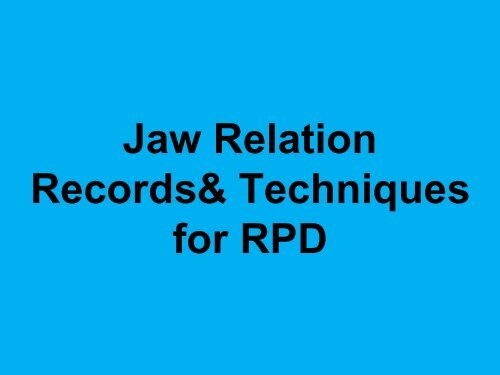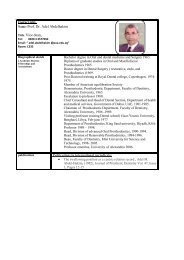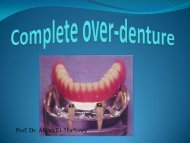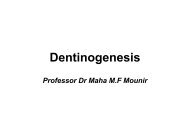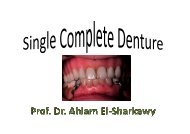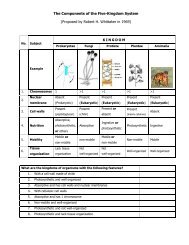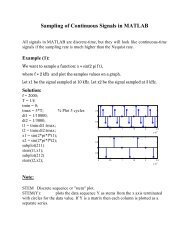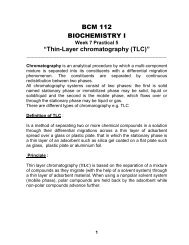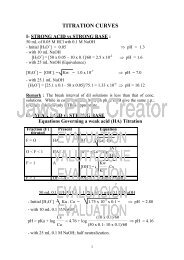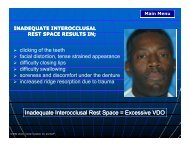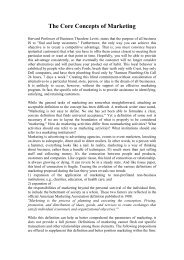Methods of Recording Jaw relations
Methods of Recording Jaw relations
Methods of Recording Jaw relations
Create successful ePaper yourself
Turn your PDF publications into a flip-book with our unique Google optimized e-Paper software.
<strong>Jaw</strong> Relation<br />
Records& Techniques<br />
for RPD
OBJECTIVES<br />
1. Arrangement <strong>of</strong> the artificial teeth<br />
2. To distribute functional forces<br />
between the remaining natural<br />
teeth & the residual ridge<br />
(harmonious occlusion)
CLINICAL APPROACH<br />
1. There are sufficient teeth present in<br />
both jaws to indicate inter-cuspal or tooth<br />
position<br />
2. There are insufficient teeth present to<br />
indicate inter-cuspal or tooth position<br />
3. One jaw is edentulous and the other is to<br />
be restored by RPD
<strong>Methods</strong> <strong>of</strong> <strong>Recording</strong> <strong>Jaw</strong> <strong>relations</strong><br />
Direct Apposition <strong>of</strong> Casts<br />
(Hand Articulation)<br />
This method can only be used<br />
when sufficient opposing<br />
teeth remain in contact to<br />
make the existing jaw<br />
<strong>relations</strong>hip obvious.
<strong>Methods</strong> <strong>of</strong> <strong>Recording</strong> <strong>Jaw</strong> <strong>relations</strong><br />
Direct Apposition <strong>of</strong> Casts<br />
(Hand Articulation)<br />
The occluded casts are secured together with the<br />
help <strong>of</strong> wooden sticks and sticky wax and<br />
mounted arbitrary on an articulator.<br />
A face-bow record is not indicated.<br />
A clinical appointment is saved by using this method.
<strong>Methods</strong> <strong>of</strong> <strong>Recording</strong> <strong>Jaw</strong> <strong>relations</strong><br />
• The remaining dentition does not provide<br />
sufficient occlusion<br />
• It is not permit occluding the casts by<br />
hands.<br />
• There are Two Possibilities:<br />
Inter-occlusal Record<br />
(Wax, Zinc oxide)<br />
Kennedy Class III<br />
Occlusal Rimes<br />
Distal extension<br />
Long bounded areas
<strong>Methods</strong> <strong>of</strong> <strong>Recording</strong> <strong>Jaw</strong> <strong>relations</strong><br />
Inter-occlusal Record<br />
Bilateral Contact <strong>of</strong> Posterior Teeth at<br />
Inter-cuspal position (ICP).
<strong>Methods</strong> <strong>of</strong> <strong>Recording</strong> <strong>Jaw</strong> <strong>relations</strong><br />
Occlusal Rimes<br />
1. The framework with the attached record block is<br />
first tried in the mouth for reconfirming the fit <strong>of</strong><br />
framework.<br />
2. An auto-polymerizing acrylic resin<br />
base is usually attached to the<br />
framework saddle areas<br />
3. A wax occlusion rim is then placed<br />
over the resin base, while<br />
considering the width and<br />
height dimensions <strong>of</strong> the natural<br />
missing teeth.
<strong>Methods</strong> <strong>of</strong> <strong>Recording</strong> <strong>Jaw</strong> <strong>relations</strong><br />
Adjusting the Occlusion rim<br />
Adjusting the Occlusal Plane following<br />
the remaining natural teeth
<strong>Methods</strong> <strong>of</strong> <strong>Recording</strong> <strong>Jaw</strong> <strong>relations</strong><br />
Adjusting the Occlusion rim
The recording medium (wax or ZnO<br />
paste) is then placed on the<br />
mandibular wax rims the patient is<br />
then guided in the desired C.O or<br />
C.R position.
<strong>Methods</strong> <strong>of</strong> <strong>Recording</strong> <strong>Jaw</strong> <strong>relations</strong><br />
• One jaw is edentulous and the other is to<br />
be restored by RPD<br />
• Vertical <strong>Jaw</strong> Relations:<br />
Rest Vertical Dimension ‘RVD’<br />
• Horizontal <strong>Jaw</strong> Relations:<br />
Occlusion Vertical Dimension ‘OVD’<br />
Centric Relation<br />
Centric Occlusion<br />
Eccentric Relations<br />
Protrusive relation<br />
Lt & Rt Lateral <strong>relations</strong>
<strong>Methods</strong> <strong>of</strong> <strong>Recording</strong> <strong>Jaw</strong> <strong>relations</strong><br />
. One <strong>of</strong> the arches is edentulous.
Vertical <strong>Jaw</strong> Relations<br />
Rest Vertical Dimension ‘RVD’<br />
Occlusion Vertical Dimension ‘OVD’<br />
Inter-occlusal Distance / Free<br />
way Space
Horizontal <strong>Jaw</strong> Relation<br />
Centric Relation<br />
‘the most retruded position <strong>of</strong> the mandible<br />
to maxilla at an established OVD’.<br />
It is a bone to bone relation
Horizontal <strong>Jaw</strong> Relation<br />
Centric Occlusion<br />
‘the relation <strong>of</strong> the mandible to maxilla in<br />
the maximum intercuspation <strong>of</strong> the teeth’.<br />
It is a tooth-tooth relation - a position <strong>of</strong> habitual<br />
closure.
Horizontal <strong>Jaw</strong> Relation<br />
What to Record – C.R or C.O?<br />
In more than 90% <strong>of</strong> people, C.O is 0.1 - 2mm in<br />
front <strong>of</strong> the CR.
Horizontal <strong>Jaw</strong> Relation<br />
What to Record – C.R or C.O ?<br />
Centric Occlusion should be recorded<br />
whenever a patient requiring a partial denture has<br />
cusps on remaining natural teeth that can guide<br />
the mandible back to this position,
Horizontal <strong>Jaw</strong> Relation<br />
What to Record – C.R or C.O<br />
C.R should be recorded, e.g., for distal extension<br />
RPD, or when the opposing arch is edentulous.
The registration obtained by means <strong>of</strong> a<br />
face-bow is called a<br />
“face-bow record”.
Obtaining & Transferring the Face-bow Record<br />
Orientation <strong>of</strong> face-bow to articulator.
Functional- Generated Path<br />
Method(Dynamic Method)
STEP BY STEP PROCEDURE FOR<br />
REGISTRING OCCLUSAL PATHWAY<br />
After the framework has been adjust to fit the mouth,<br />
the technique for registration <strong>of</strong> occlusal pathways<br />
is as follow:<br />
1. Support the wax occlusion rim by a denture base<br />
having as same degree <strong>of</strong> accuracy and stability as<br />
the finished denture base.<br />
The wax used for the occlusion rim should be hard<br />
enough to support biting stress and should be tough<br />
enough to resist fracture.( purple hard inlay wax)<br />
2. Inform the patient that the occlusal rim must be worn<br />
for 24hours or longer. It should be worn constantly,<br />
including night-time, excepts for removal during<br />
meal. By wearing and biting into a hard occlusal rim ,<br />
record is made <strong>of</strong> all extent <strong>of</strong> jaw movement
STEP BY STEP PROCEDURE FOR<br />
REGISTRING OCCLUSAL PATHWAY<br />
3. After 24 hours the occlusal surface <strong>of</strong> the wax<br />
rim should show gloss generated pathways.<br />
Which indicate functional contact with opposing<br />
teeth in all extreme <strong>of</strong> movements.<br />
Any are <strong>of</strong> deficient are add this time.<br />
4. These generated pathways are reproduced by<br />
stone. Each grove in wax representing pathway<br />
<strong>of</strong> a cusp becomes a ridge <strong>of</strong> stone<br />
5. Artificial teeth are arranged on the RPD<br />
framework to inter-cuspate with the pathways <strong>of</strong><br />
their antagonists
This method eliminate the need <strong>of</strong> face bow transfer<br />
Bec. Patient himself, is the best articulator for<br />
developing occlusion.
GUIDELINES FOR CHOICE OF OCCLUSAL<br />
CONCEPT FOR PARTIALLY EDENTULOUS<br />
PATIENTS<br />
Maxillary arch Mandibular arch Occlusal concept<br />
1 Fully edentulous<br />
restored by CD<br />
Kennedy Class I<br />
restored by RPD<br />
2 Fully dentate Kennedy Class I<br />
restored by RPD<br />
Balanced occlusion<br />
(working, Balancing,<br />
protrusive)<br />
Working side contact<br />
3 Kennedy Class I<br />
restored by RPD<br />
Fully dentate<br />
Working & Balancing<br />
side contact<br />
4 Kennedy Class II Fully dentate Working side contact<br />
5 Fully dentate Kennedy Class III Working side contact<br />
6 Kennedy Class III Kennedy Class III Working side contact<br />
7 Kennedy Class IV Fully dentate Contact in centric<br />
No eccentric contact


